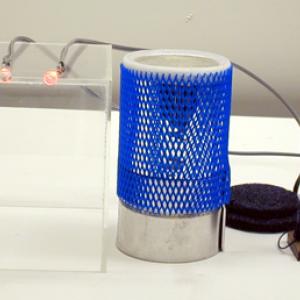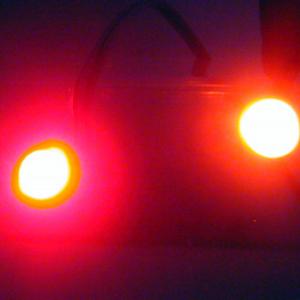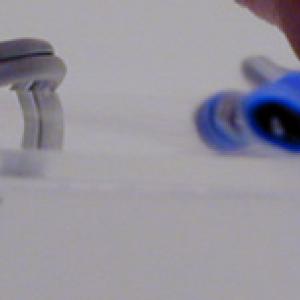College of Liberal Arts & Sciences
7A70.50 - Cool a PN Junction - LED Band Gap
Plug in two LED's and show that they have the same visible frequency or color. Dip one of the LED's into liquid nitrogen until it is as cold as possible. Remove and place beside the other LED. Visible color change should be apparent.
Yellow LED Color Change vs. Voltage
Attach a single 8mm yellow LED to the Hewlett-Packard Model 721 power supply with the current range set to the 225 ma scale.
Turn up the voltage until the current goes well past 25 ma. The LED will change color from yellow to a reddish brown.
Dunk the LED into the liquid nitrogen for a short time and observe the color shift to orange.
Dunk the LED into the liquid nitrogen for a longer time and observe the color shift go past orange to yellow, and then to yellow green.
If you then turn down the voltage at the yellow green stage so that the current goes below 20 ma, you will see that the color shifts to a bright green. Allow the LED to warm up at this stage and you will see the color shift back to yellow.
- Gorazd Planinšič and Eugenia Etkina, "Light-Emitting Diodes: A Hidden Treasure", TPT, Vol. 52, #2, Feb. 2014, p. 94.
- John W. Jewett, "Get The LED Out", TPT, Vol. 29, # 8, Nov. 1991, p. 530.
- J. A. Davis and M. W. Mueller, "Temperature Dependence of the Emission from Red and Green Light Emitting Diodes", AJP, Vol. 45, # 8, Aug. 1977, p. 770.
- John B. Kwasnoski, "A Laboratory Investigation of Light-Emitting Diodes", AJP, Vol. 40, # 4, Apr. 1972, p. 588.
- Charles Day, "Light-Emitting Diodes Reach the Far Ultraviolet", Physics Today, July 2006, p. 15.
- Charles Kittel, Introduction to Solid State Physics 5th Edition, John Wiley & Sons, Inc.
- "Photonic-Crystal Advances", How it Works - Science Supplement, Spring 2000, pp. 319.
- T. D. Rossing, C. J. Chiaverina, "# 6.8, Light-Emitting Diodes", Light Science, Physics and Visual Arts, p. 140.
- George C. Lisensky, Rona Penn, Margret J. Geselbracht, and Arthur B. Ellis, "Periodic Properties in a Family of Common Semiconductors: Experiments with Light Emitting Diodes", Journal of Chemical Education, Vol. 69, #2, Feb. 1992, p. 151.
- Keithley Instruments, "Physics Experiment # 4: Energy Gap in A Semiconductor, Series I.
- Joseph Florentine, David Maiullo, "Shifting Bandgaps: LEDs in Liquid Nitrogen", Rutgers Physics Lecture Hall.
- Tap-L Conversations, Oct. 6, 2008.
Disclaimer: These demonstrations are provided only for illustrative use by persons affiliated with The University of Iowa and only under the direction of a trained instructor or physicist. The University of Iowa is not responsible for demonstrations performed by those using their own equipment or who choose to use this reference material for their own purpose. The demonstrations included here are within the public domain and can be found in materials contained in libraries, bookstores, and through electronic sources. Performing all or any portion of any of these demonstrations, with or without revisions not depicted here entails inherent risks. These risks include, without limitation, bodily injury (and possibly death), including risks to health that may be temporary or permanent and that may exacerbate a pre-existing medical condition; and property loss or damage. Anyone performing any part of these demonstrations, even with revisions, knowingly and voluntarily assumes all risks associated with them.



